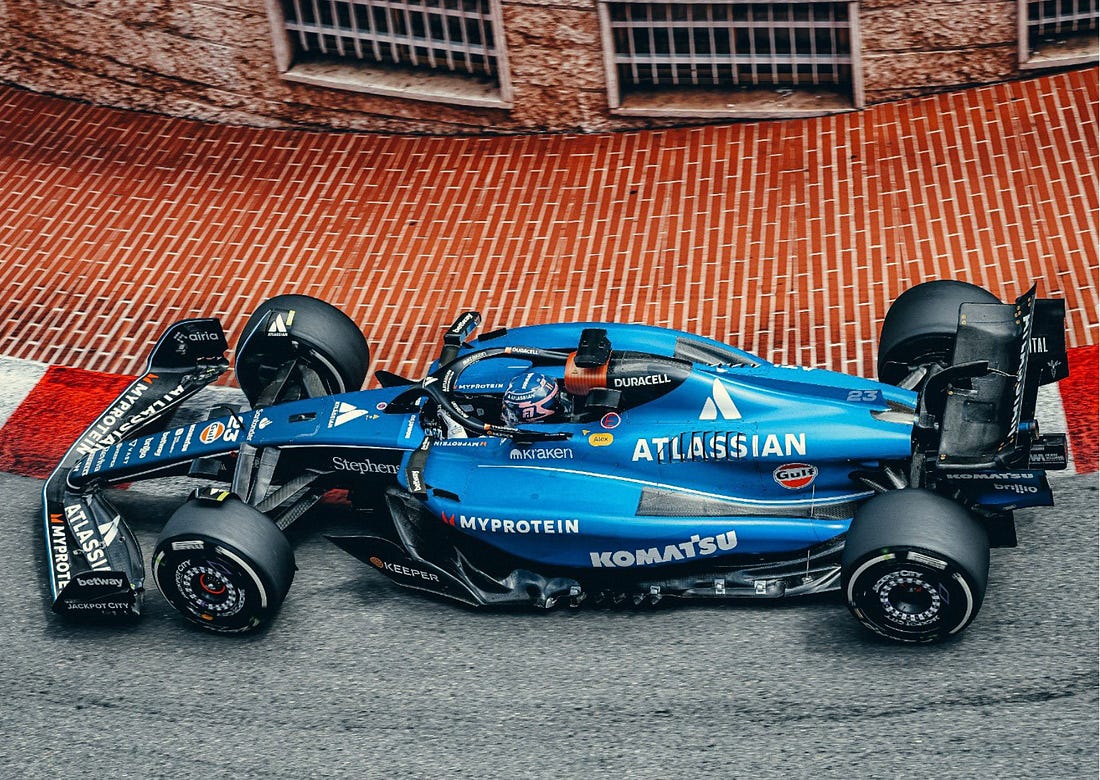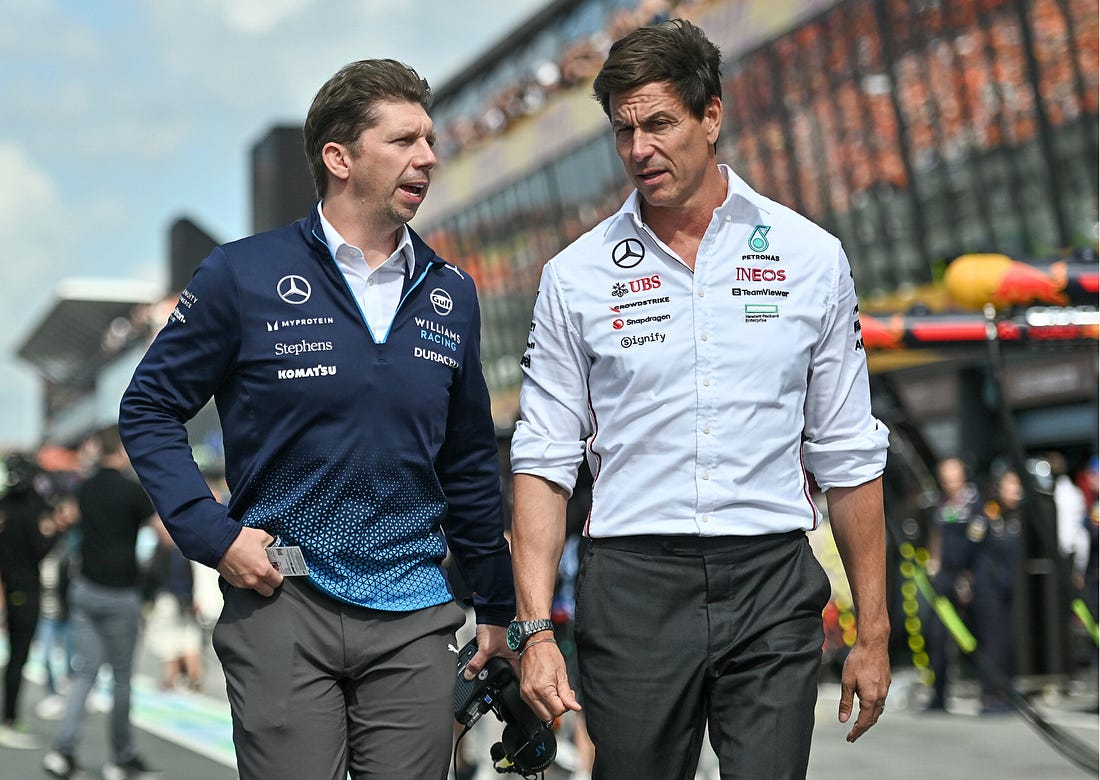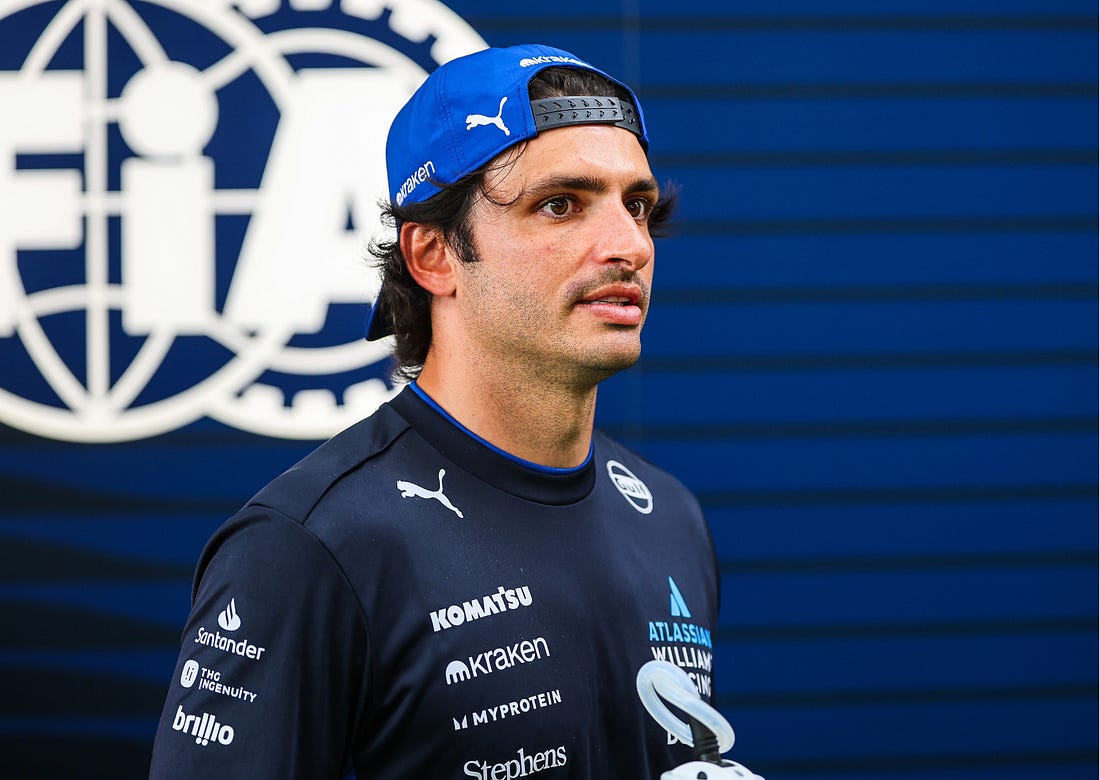Inside the $200 Million Gamble That’s Turning Heads in Formula 1
Inside the $200 Million Gamble That’s Turning Heads in Formula 1The Williams F1 team was tracking 14,000 car parts in a single Excel sheet. Now, they’re a top-five team. Here’s how Toto Wolff’s right hand man is rebuilding one of Formula 1’s most historic teams.
When the Williams Formula 1 team announced James Vowles as its newest team principal in 2023, many people within the paddock were surprised. Vowles was the chief strategist at Mercedes. Second in command to billionaire team principal Toto Wolff, Vowles contributed to eight consecutive Constructors’ titles and seven Drivers’ titles. Williams had a rich history as Formula 1’s third-oldest team, but why would Vowles leave the sport’s most successful team to join its last-place team? Mercedes had over 1,000 employees, a waiting list of sponsors, and F1’s most advanced wind tunnel; Williams had a few hundred employees, a slow car, and a near-empty bank account. Transitioning from chief strategist to team principal was a promotion, but that doesn’t mean it wasn’t a gamble. Formula 1 is a cutthroat sport. It doesn’t matter if you are a driver, team principal, or mechanic. If you don’t perform, you get replaced. Williams had already gone through three team principals in the previous decade, with two of them lasting less than 24 months. It’s not hyperbole to say that almost everyone thought it was an impossible job with none of the necessary resources to succeed. That didn’t matter to Vowles, though. He moved his desk 40 minutes south from the Mercedes factory in Brackley to the Williams headquarters in Grove. And despite only being two years into the turnaround, Williams is already showing promising signs. Williams has scored more points over the last eight races (54) than they did over the previous three years combined (53). Once seen as a perpetual backmarker, Williams has solidified itself as a midfield contender. They are currently 5th in the standings, behind McLaren, Mercedes, Red Bull, and Ferrari, but ahead of everyone else. While still in its early stages, the turnaround at Williams is reminiscent of what has happened at McLaren. Rather than applying patchwork solutions to appease shareholders, Vowles has spent the last 24 months tearing everything down. He has hired dozens of new employees, both in technical and non-technical departments. The team’s entire technology stack has been rebuilt from the ground up, and Williams’ new ownership group, Dorilton Capital, is poised to achieve a massive financial return. The Williams Formula 1 team has undergone several transitional periods over the last few decades. First came the glory days. Founded in 1977 by Sir Frank Williams and Patrick Head, Williams became one of Formula 1’s most successful teams. Over four decades, they won nine Constructors’ Championships and seven Drivers’ titles, with legends such as Nigel Mansell, Alain Prost, and Damon Hill piloting their F1 cars. This era propelled Williams into the minds and hearts of Formula 1 fans worldwide. Ferrari and McLaren were the only other teams to have more wins entering the 2000s, but Williams was able to accomplish this feat as an independent team, meaning they didn’t have any luxury cars or cheap energy drinks to sell to make up for their losses. In the 2000s, Williams remained competitive but slightly off the championship pace. A partnership with BMW yielded race wins in the early 2000s but no titles, and after BMW’s departure in 2005, Williams struggled to stay at the front. By the early 2010s, Williams had firmly established itself as a midfield team. A switch to the Mercedes power unit in 2014 led to a couple of third-place finishes in 2014 and 2015, but this decade marked the start of a steep decline that Williams is still recovering from. In 2018, Williams missed the first two and a half days of preseason testing because the team’s FW42 car was not ready in time. They only scored seven points all season and plummeted to 10th (last) place in the standings. Yet, things somehow got worse. Williams only scored a single point in 2019 and zero points the entire 2020 season. There were a few bright spots during the early 2020s, like when George Russell earned a podium finish at the 2021 Belgian Grand Prix. However, Russell only earned that podium because the race was red-flagged due to heavy rain after just a handful of laps, and there haven’t been many bright spots since. Budget constraints forced Williams to rely on pay drivers for additional sponsorship revenue — Lance Stroll and Nicholas Latifi. The team was operating on such a tight budget that in-season car development was non-existent; Williams was often lapped by other cars within 20 laps. Huddle Up is a reader-supported publication. To receive new posts and support my work, consider becoming a free or paid subscriber. This is when James Vowles entered the picture. If you were to ask him, I imagine he wasn’t even sure what he was getting himself into at the time. American-based private equity firm Dorilton Capital had recently purchased the team for $200 million, but Williams was losing tens of millions of dollars annually, and morale was disastrous. To highlight just how dire the situation was, when Vowles arrived at the factory, he discovered that the team had no internal technology to track the development and production of car parts. Every single one of the 14,000+ parts on the team’s Formula 1 car was being tracked in a single Excel spreadsheet, a far cry from the sophisticated Product Lifecycle Management (PLM) system that Mercedes had built in-house to monitor parts from design to build to racing. This gap was causing inefficiencies and miscommunications within Williams, wasting precious time and resources. Not to mention, it was a big reason why the Williams car missed preseason testing in 2018. Fortunately for Williams, Vowles was uniquely equipped to handle the challenge. After graduating from university with degrees in math and computer science, Vowles sent a letter to every Formula 1 team asking for a job. Only two teams replied, but they didn’t give him the answer he was looking for. Formula 1 teams didn’t need any more mathematicians. They needed more engineers, so Vowles went back to school. In 2001, Vowles eventually got his start as a data acquisition engineer with British American Racing, staying with the team through its transitions to Honda Racing F1, Brawn GP, and Mercedes. He worked with world-class drivers like Jacques Villeneuve, Jenson Button, Michael Schumacher, Lewis Hamilton, and Nico Rosberg, eventually becoming known around the paddock as a potential successor to Toto Wolff. But with Wolff not ready to leave Formula 1 anytime soon, Vowles made the jump to Williams. Vowles was such a unique hire for Williams because he knew what a championship team looked like. From the mindset that drivers needed to win races to how sponsors should be treated in the Paddock Club to the way engineers should communicate over the radio during the race, Vowles received a crash course in excellence under Wolff. Within weeks of taking the job at Williams, Vowles set expectations. He was clear from the beginning that this wouldn’t be a one or two-year turnaround; he needed to rebuild the entire organization from the ground up. If Dorilton Capital was lucky, Williams could potentially compete for podiums in 2026 — a long three years and hundreds of millions of dollars in budget away. The good news for Vowles was that Williams finally had the financial backing it needed to make substantive changes. Vowles started this journey by prioritizing people. Williams had been without a Chief Technical Officer (CTO) for four years, so his first major hire was Pat Fry. The highly respected engineer had over 30 years of experience in Formula 1, but that was just the tip of the iceberg. Over the following two years, Vowles embarked on an aggressive recruitment campaign, bringing 26 new hires from rival teams across the paddock. By August 2024, Vowles said he had hired “close to 250” people since taking over Williams the previous year. This included personnel across all departments — design, manufacturing, race engineering, and operations — and it meant that Williams was now moving closer to the 900-1,000 headcount seen at Mercedes and Red Bull. Huddle Up is a reader-supported publication. To receive new posts and support my work, consider becoming a free or paid subscriber. While hiring people is one pillar of Vowles’ rebuild, the other is giving them the tools to succeed. This is an ongoing battle, as Vowles says that Mercedes has approximately $300 million worth of equipment that Williams doesn’t currently possess. To make matters more difficult, Mercedes and other top teams like Red Bull and Ferrari were able to lock in these facility advantages before the cost cap was implemented in 2021. Williams eventually convinced F1 to add a cost cap exemption for special projects, such as wind tunnels and race day simulators. But those are multi-year projects, so Vowles began by focusing on short-term gains like increasing wind tunnel efficiency, utilizing 3D printing for rapid prototyping, and automated machinery for precision. This seems to be one of Vowles’ superpowers. While many Formula 1 teams struggle to allocate resources between upgrades for this year’s car and prototypes for next year’s car, Vowles has almost exclusively focused on improving systems now so that they can take advantage of them later. In fact, Vowles has publicly said that he would be okay if Williams didn’t score a single point during the 2023, 2024, and 2025 seasons. Vowles’ leadership style is most accurately described as people-first. He preaches a no-blame, collaborative environment. Every time you hear Vowles talk, he’s rarely ever talking about himself. It’s always what everyone else is doing to help the team win. More importantly, Vowles’ transparency and accountability have enabled the team’s ownership group and fans to buy into his vision. By openly discussing Williams’ shortcomings with the media, rather than keeping them a secret, Vowles sets realistic expectations while making himself and the team accountable for addressing the issues. This approach is a big reason why Williams now has one of the sport’s strongest driver lineups. The rebirth of Alex Albon at Williams after leaving Red Bull Racing, combined with Vowles’ vision, was a massive factor in the team landing Carlos Sainz this past offseason. Vowles says these two are the perfect drivers for Williams because they are fast, but also collaborative, willing to do whatever it takes to help the team. Pairing Carlos Sainz with Alex Albon has already paid dividends on the track. Given their experience, they can optimize the current car’s performance while also providing the team with valuable feedback on next year’s car. If the current standings were to hold, Williams’ 5th-place finish would earn the team ~$100 million in prize money. While helpful, prize money is only one part of the equation. Instead of being seen as a perennial backmarker or a nostalgic old team, Williams is rebranding as a “resurgent contender.” This underdog approach has helped the team convince sponsors to get in on the ground floor. Examples include a title sponsorship deal with Atlassian, as well as deals with Gulf Oil, Duracell, Kraken, Santander, Michelob Ultra, and Stephens. Despite F1’s cost cap sitting at $140.4 million this year, Williams has historically operated on a budget far smaller. But now that they have the financial backing of Dorilton and a handful of lucrative sponsorship deals, they plan to use the entire budget going forward, effectively leveling the playing field with their competitors. An increased budget helps with everything from car development to headcount. The cost cap also increases the enterprise value of the team because, rather than having teams spend hundreds of millions to lose tens of millions each year, most Formula 1 teams are now profitable. Williams isn’t there yet, but that’s only because they have been investing a ton of money in the team’s infrastructure. Once that investment is completed, the financials begin to resemble the NFL’s salary cap system (e.g., controlled costs with guaranteed profits from TV revenue and sponsorship deals). Williams has made significant progress so far, but what’s truly important is next year. While F1’s top teams commit a large percentage of their resources to the ongoing development of this year’s car, Vowles has already said that Williams won’t be making any more updates throughout the year. Instead, they are fully focused on the 2026 car. Formula 1’s new regulations next year provide an opportunity for Williams to make a monumental leap. The team has spent the last couple of years reviewing all 260 pages of technical regulations, seeking any potential advantages. They have come up with thousands of car designs, eliminating them one by one based on computer-simulated aero performance. The best options are then built at 60% scale for wind tunnel testing. We are not even halfway through the 2025 F1 season, but 2026 will be here before we know it. In less than nine months, teams will show up in Barcelona for pre-season testing. Cadillac will be the talk of the town as F1’s newest team, but for the first time in a long time, the top teams will be watching closely when Williams opens its garage. If Williams pulls this off, it won’t just be a comeback — it’ll be one of the best turnarounds Formula 1 has ever seen. Vowles didn’t leave Mercedes to run a team stuck in the midfield; he came to rebuild one of the sport’s most iconic teams from the ground up. The stopwatch will tell the whole story, but one thing’s already obvious: Williams isn’t clinging to its past anymore; they are focused on an ambitious future. If you enjoyed this breakdown, share it with your friends. Huddle Up is a reader-supported publication. To receive new posts and support my work, consider becoming a free or paid subscriber. You’re currently a free subscriber to Huddle Up. For the full experience, upgrade your subscription.
© 2025 |




